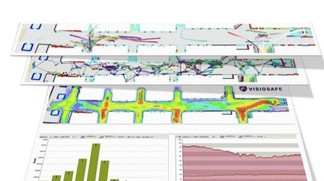Nov 27 2012
Analyzing the behavior of pedestrians in public places can help adapt infrastructures of the future. This is the joint project of the startup Visiosafe, the Transportation Center at EPFL, and the Swiss Federal Railways (SBB). Around 100 motion sensors installed in Lausanne train station for several months deliver their first data.
 © 2012 EPFL
© 2012 EPFL
Moving through Lausanne train station at rush hour can be a real challenge for anyone in a hurry to catch a train. And it is predicted that will worsen through the years. By 2030 the number of passengers on board trains between Lausanne and Geneva, for example, is expected to increase from 50,000 to 100,000. What, then, can be done to manage the increased flow of pedestrians at the stations? To investigate the best approach before the transformation of Lausanne station (currently planned for 2030) the SBB commissioned the Transportation Center of EPFL and the startup Visiosafe to use sensors to model the behavior of pedestrians in the crowd.
Infrared preserves anonymity
The experiment was conducted in two stages. It was first necessary to collect the data, then to analyze it. For four months, nearly 100 infrared sensors developed by Visiosafe were divided into two subchannel passageways at the station, as well as on platform number 2. These Kinect movement detectors, the same ones found in video game consoles such as Xbox, are actually depth sensors. This means they identify the distance separating them from different people in the crowd. That makes it possible to map a situation and to distinguish different shapes without anyone being recognizable.
article capteurs gare de Lausanne
With these accurate renderings of the flow of travelers, two EPFL researchers have developed, in a second step, an extremely precise “tracking” system. The goal is to understand the routes travelers choose, such as the type of exit taken or the way to move around obstacles, and to analyze the density and speed of movement, or even to develop simulations. For example, virtually increasing the number of people in the station makes it possible to simulate the conditions of traveler flow in 2030.
“Current systems do not allow for such analyses,” explains Jean-Philippe Thiran, of EPFL’s Signal Processing Laboratory 5. “They assume that each person will move straight ahead, no matter what happens. In addition, when two people cross in front of the sensors, the pedestrian’s trail is quickly lost.”
Probabilities associated with the image analysis
To address these weaknesses, the researchers used a trick: they integrated a model of mathematical probability in an extremely robust “tracking” system. Michel Bierlaire, of the Transport and Mobility Laboratory at EPFL, used real data to establish the probabilities of movement for each user. On the images, each pedestrian is therefore continuously surrounded by several points that more or less represent the movement likely to being carried out when an obstacle is encountered.
Probabilistic calculations were then associated with a system of algorithms developed under the direction of Jean-Philippe Thiran. The goal: to segment the images and accurately track the subjects. Through the combinations of these two technologies, gone are the problems related to the “overlap” of two silhouettes. When several people cross, the system is able to adapt so as not to lose sight of the subject.
The last step: simulations
Completed several weeks ago, the first phase of data collection will now be followed by simulations. Virtually increasing the number of passengers in the station can provide valuable information on how best to renovate infrastructure. “This will identify the places most likely to be clogged and then conduct the work accordingly,” states Jean-Philippe Thiran. “We are collecting the same type of data from the station in Basel,” claims Philippe Schmidt, spokesperson for SBB. “We could even imagine, in the future, applying this system to other stations in Switzerland.” Meanwhile, the analysis continues. More precise results on platform number 2 should be released in the spring.